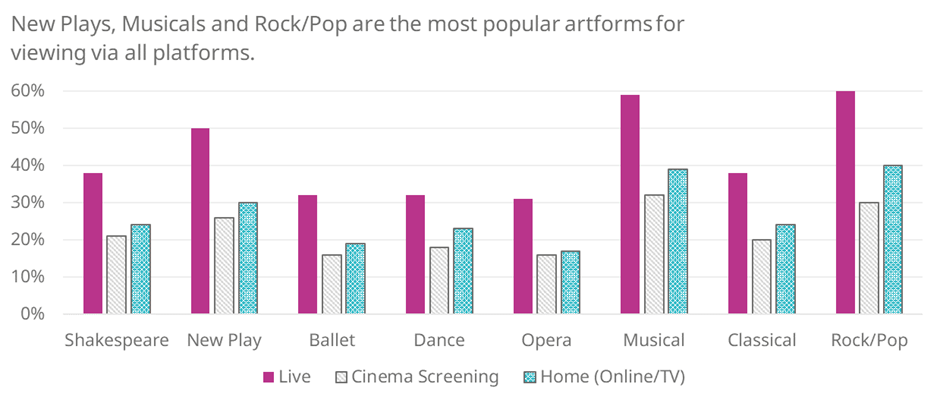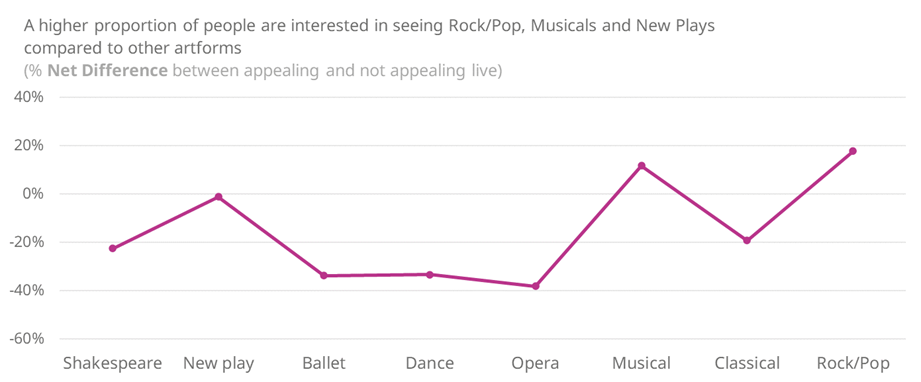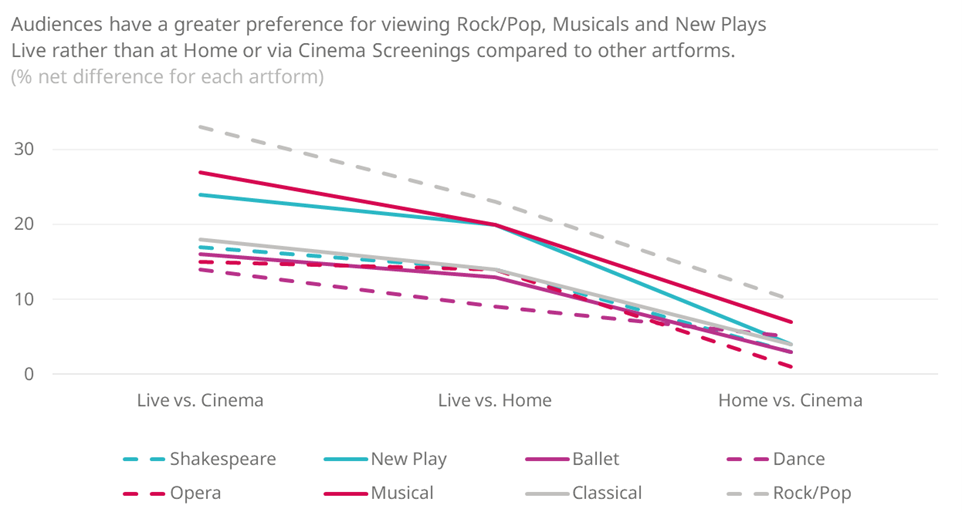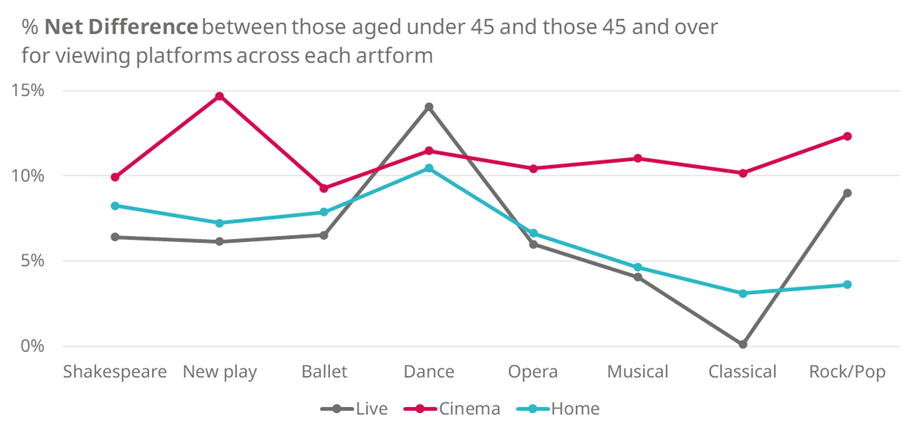Audiences prefer live events, but how much varies by artform
January 2024
This research is from The Audience Agency's nationwide longitudinal (ongoing) panel survey of changing views about participating in creative and cultural activities through the recent and ongoing crises, and beyond, the Cultural Participation Monitor.
Themes
Data from the CPM suggests that the more popular an artform is the more open audiences are to viewing it in different formats other than live. This report presents insights into how the popularity of an artform and the initial audience interest can determine how engaging people find non-live events for a particular artform.
Key Takeaway Points
- New Plays, Musicals and Rock/Pop artforms are the most appealing across all viewing platforms
- Younger audiences are more interested in viewing Classical music via other viewing platforms to live events
- Dance is more appealing to those under the age of 45, and preferences for viewing Dance does not change based on the viewing platform
- Dance, Opera and Ballet are the least popular of the art forms asked about and the ranking of preferences do not change based on viewing platform
There is a greater disparity between viewing platform preferences for New Plays, Musicals and Rock/Pop
These three artforms are more popular across all viewing platforms compared to others which may account for the greater difference between those who are open to viewing them live and those who would view them at the cinema or at home. Furthermore, Musicals and Rock/Pop artforms are the only ones to fall in the positive when accounting for those who do not find these artforms appealing. New Plays break even for those that find live viewing appealing versus not appealing, with Musicals at 12% and Rock/Pop at 18%. All other artforms are at -20% or lower, demonstrating that a greater number of people do not find these live artforms appealing than those who do.

There is only a 1% difference between viewing Operas at the cinema versus at home, demonstrating this artform's similar appeal across viewing platforms, whilst Rock/Pop, New Play and Musicals have a greater difference for all viewing platforms. Ballet, Shakespeare and Classical all have less than 5% difference between preferences for viewing via at home versus at a cinema screening and a similar difference between live viewings compared to at home or at the cinema.

Dance has the least difference between all viewing platforms suggesting that this artform is not preferred more when changing the viewing platform. Overall, the more popular artforms appeal more for live events, whilst the less popular artforms generally appeal less for all viewing platforms.

Lower engaged segments differ in interests to higher engaged segments
When only considering those that find artforms appealing, Experience Seekers stand out amongst the higher engaged segments as the most interested in viewing via alternative platforms to Live events. 43% of Experience Seekers find a Musical at home appealing (cf. 36% Metroculturals), and 27% for a classical performance in a cinema (cf. 16% Commuterland Culturebuffs). Lower engaged segments are more interested in seeing Rock/Pop artforms live, however, Frontline Families had the highest level of interest compared to all segments in seeing New Plays at home (18%) or in the cinema (17%).
Interestingly, all Audience Spectrum segments find New Plays appealing the least, followed by Musicals and then Rock/Pop, except for Commuterland Culturebuffs, Experience Seekers and Up Our Street, who found Musicals the most appealing of all artforms.

Age further illustrates that viewing preferences are dependent on the artform
Age demonstrates a slightly different picture. Younger audiences are overall more open to viewing events at home and at cinema screenings compared to older people, however, this does differ depending on the artform. For instance, more 16-24s than those 45 and over say Dance is appealing (a little/a lot) for live events (16% more), but also for cinema screenings (11% more) and at home viewing (10% more).
However, Classical music and Shakespeare show a different picture. These appeal to a higher proportion of those aged 25-44 (42% and 43% respectively), and with those over the age of 65 (43%). Overall, Classical music has an even level of interest for live viewing between those aged under 45 and those 45 and over, but when considering at home and cinema screenings, younger audiences are more interested in seeing Classical music compared to those aged 45 and over. This suggests that although Classical music attracts an older audience comparatively for live events, younger audiences are more open to attending this artforms’ events over a variety of viewing platforms other than just live.

In summary, depending on the artform and the level of initial interest in it, people’s willingness to view it across non-live platforms is greater if they are already interested in the artform itself. However, younger audiences are more open to viewing a variety of artforms via other platforms than live events in general, as are Experience Seekers.
Related videos
TEA Break | Following Arts and Cultural Organisations on Social Media
Watch nowCultural Participation Monitor | Latest Findings on Audience Attitude and Behaviours | Wave 9
Watch nowOther findings from Wave 9 | Jul 2023 | Live/digital, social values. audience behaviour
-
Cost of Living
It’s no surprise that the UK population feel worse off than they did last year (33% feeling worse off, 49% about the same and only 18% better off, a net 15% reduction).
-
Audiences prefer live events to digital
This report uses data from wave 9 of the Cultural Participation Monitor (CPM) to understand the extent audiences engage with live versus digital events, finding that:
- All audiences prefer live events, followed by at home viewing and then watching at a cinema screening.
- Lower engaged segments are more open to viewing at home and at the cinema compared to higher engaged segments.
- Younger people are more open to all viewing platforms and artforms compared to audiences aged 45 and over
-
Audience preferences on venues' values
Social and environmental issues are at the forefront of much news about the cultural sector recently: cancellation of fossil fuel sponsorships; repatriation of museum artefacts and decolonialisation of collections and displays; demonstrations of support for Black Lives Matter; the emphasis on environmental action in Let’s Create and National Portfolio funding, to name but a few topics. But where is the voice of the audience in these discussions?
